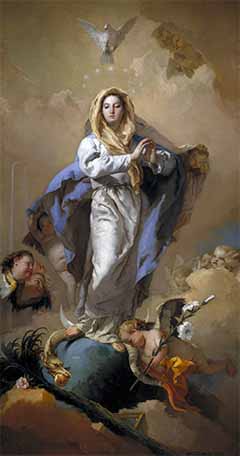Story of Saint Bernadette of Lourdes
Marian Apparitions

On February 11, 1858, looking for wood with her sister and a friend, Bernadette Soubirous goes to the Massabielle Grotto, near Lourdes. Suddenly, in the hollow of the rock, she sees a "light" ...
The wonderful story of Saint Bernadette of Lourdes

Suffering from asthma and tuberculosis, this 14-year-old girl looks 12 years old. As a child of a ruined miller, St. Bernadette never learned enough catechism to make her first communion. However, that day, a "beautiful lady" dressed in white, holding a rosary, appears to her. On the 14th, the child returns and starts throwing holy water in order to make sur that it isn't a trick of the devil. From February 18 to March 4, the apparition is renewed almost every day, then three more times, at the end of March, in April and in July.

The "beautiful lady", often silent, delivers in patois a message of resignation and penance and invites St. Bernadette to drink the water of the Lourdes cave and to wash with it, asks that one come to the place in procession and that one builds there a chapel. On March 25, she said to be Immaculada Concepcion: the dogma was proclaimed only 4 years earlier by Pius IX.
Lourdes first miracle
In town, Bernadette Soubirous speaks. She is the only one to see the "beautiful lady", but more than 1,000 people follow her on February 28th, and perhaps 8,000 on March 4th. On March 1, a certain Catherine Latapie sees her hand healed, after soaking it in the water of the cave: this is the first of Lourdes miracles. But it is above all the reference to the Immaculate Conception that convinces religious authorities: the poor child that is St. Bernadette could not have invented this name, which she does not understand.
Modest and selfless, Bernadette Soubirous does not lie. She derives no glory from a celebrity who quickly becomes national, even flees the visitors and manifests the greatest humility. Saint Bernadette spends the last 13 years of her life far from Lourdes cave, in a convent of Nevers and dies in 1879, at the age of 35. From 1862, the bishop of Tarbes, on which depends Lourdes, recognizes the authenticity of the marian apparitions. Long before, the police, who had first closed the cave, reopened it, by order of Napoleon III himself.
Lourdes healing and Lourdes pilgrimage
Beyond what Bernadette saw, there are miracles. Thirty-two healings took place in 1859; 7 are inexplicable by medicine of the time. And this justifies the importance of the pilgrimage, facilitated by the railway that reached Lourdes May 19, 1866 and soon taken in hand by the members of the congregation of the Assumptionists, who organize in 1874 the first national pilgrimage of the sick. From then on, the success of Lourdes is no longer deceiving, the million annual visitors is reached in 1908, and their number quadruple in the following century.
More miracles and healings in the cave of Lourdes
The Church, however, does not hastily recognize Lourdes inexplicable healings, fearing deceit. Above all, it is more and more concerned with developing a more inner faith, less attached to the spectacular. So it imposes a triple control (which will be really picky from 1946).
On site, the Medical Office examines the 30 to 50 cases reported each year. It judges the reality of evil, the definitive character of healing; often, the investigation is short, many treating physicians reluctant to testify. Then, once a year, an International Medical Committee sorts the files transmitted by the Bureau in Paris. Finally, the bishops of the dioceses of the "miraculas" surveyed are investigating, following the procedure of the canonization trials.
This triple filter explains that, out of more than 5,000 cases, the Church now recognizes only sixty real Lourdes miracles: the first, in 1858-1859, then those that have been the subject of serious investigations from 1907 to 1913, and since 1947.
Spontaneous healings
In spite of the rigorous examination to which they have been subjected, the official Lourdes miracles remain suspect to the eyes of some: one can always invoke the simple emotional shock or the psychosomatic phenomenon although the cure of functional or psychic diseases is never recognized as miraculous.
But it must also be remembered that sometimes inexplicable healings of patients considered as "condemned" by medicine take place in a setting that is not religious, if only in the hospital - and whether the sick are believers or unbelievers. The origin of these spontaneous healings is undoubtedly to be found in the secrets of physiology and human psychology.
Bottled religion
Thus, between the skeptical rationalists and the faithful convinced of the reality of miracle, a dialogue of the deaf is most often established. Especially as the spectacle offered by Lourdes, a mixture of mercantilism and exaltation, can exasperate. Fifteen years after the marian apparitions, Pierre Larousse already ironises on "this way to bottle religion, this lucrative exploitation of miracles" ...
The cult of Mary
The French nineteenth century, heir to 1789, is marked by rationalism and dechristianization. But it also sees great efforts of Catholic reconquest. A clergy of more popular origin, and closer to Roman sensibility, insists on the blessings, the processions, the devotion to the saints and especially to the Virgin Mary.
In 1854, Pius IX made a dogma of the tradition that the mother of Christ was conceived while being preserved from original sin: it is the Immaculate Conception. New sanctuaries are dedicated to the Virgin: Fourvières in Lyon, Notre-Dame de la Garde in Marseille. But the major element of this cult is marian apparitions : the miracle is proof in favor of faith.
The Virgin addressing young girls or children, often from very modest backgrounds, speaking more patois than French, shows a new audience for the Church of France - a female audience, popular, even marginalized - at a time when paths of power are closed to its influence.









































































































































































































































































































































